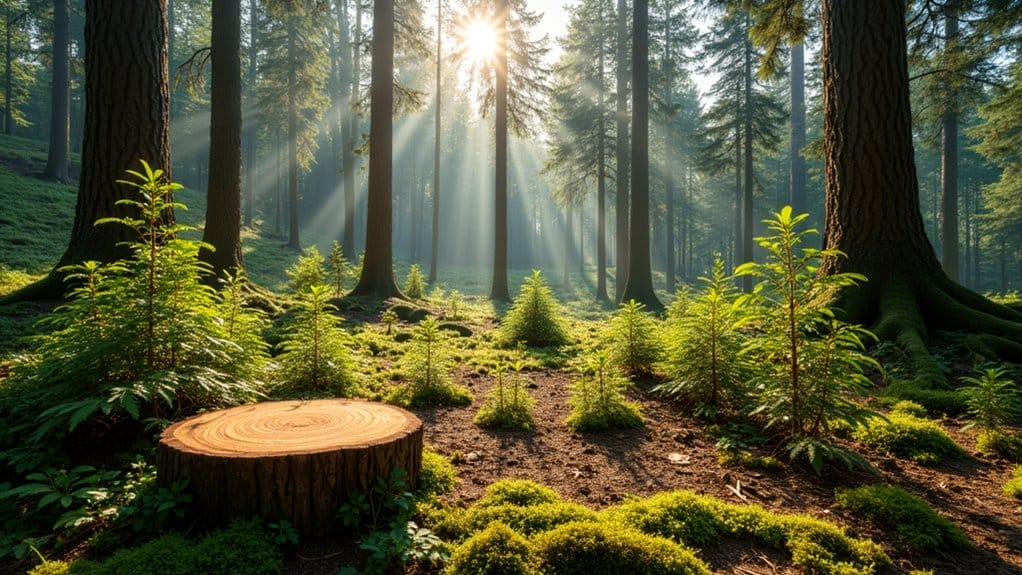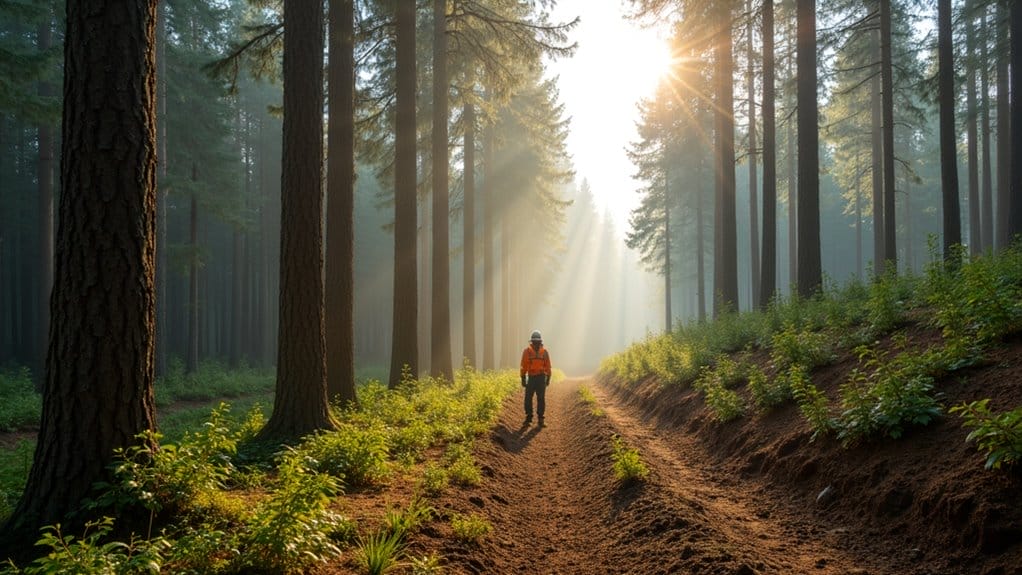You’ll find wood’s classification as a renewable resource isn’t as straightforward as it might seem. While trees naturally regenerate through growth cycles, factors like harvest rates, land management practices, and ecological impacts complicate the equation. Current global data shows that forests cover 31% of Earth’s land surface, but we’re losing 10 million hectares annually. Understanding these dynamics is essential for making informed decisions about wood sustainability and resource management.
Key Takeaways
- Wood is a renewable resource because trees naturally regrow through biological cycles, with harvest rotations typically ranging from 20-100 years.
- Sustainable forest management ensures wood remains renewable by maintaining balanced harvest rates that don’t exceed natural regeneration.
- Trees store carbon during growth and wood products continue storing it for 50-100 years, contributing to environmental sustainability.
- Certification systems like FSC and PEFC verify sustainable wood sourcing, helping consumers choose responsibly harvested wood products.
- Wood’s renewable status depends on proper management practices that protect forest health, biodiversity, and long-term resource availability.
Is Wood a Renewable Resource?

To classify wood as renewable or nonrenewable, you’ll need to evaluate if it’s naturally replenished within a human timescale and if its regeneration rate exceeds its consumption rate.
Wood meets the biological renewability criteria since trees can regrow through natural reproduction and forest management practices, with typical harvest rotations ranging from 20-100 years depending on species.
While forest ecosystems can regenerate through succession, you’ll find that sustainable wood production requires careful management to maintain long-term resource availability and prevent deforestation.
Renewable vs Nonrenewable — Basic Criteria
Before classifying wood as renewable or nonrenewable, you’ll need to understand the fundamental criteria that define these resource categories.
A renewable resource can naturally regenerate and replenish itself within a short period of time, typically within a human lifespan. You’ll find these resources maintain their availability through natural cycles.
Non-renewable resources, in contrast, exist in fixed amounts and deplete without the ability to replenish quickly. Once consumed, they take millions of years to form again.
The key distinguishing factor is the resource’s regeneration rate compared to its consumption rate.
Biological Renewability of Wood and Forest Regrowth
Wood stands as a biologically renewable resource based on its natural growth and regeneration cycles.
Through proper forest management practices, you’ll find that wood can be continuously regenerated through careful cultivation and sustainable harvesting methods. The growth of trees follows predictable biological patterns, with new saplings replacing harvested mature trees.
When you examine forestry data, you’ll see that well-managed woodlands can produce renewable material indefinitely if harvest rates don’t exceed natural regeneration.
This biological renewability depends on factors like growth rates, species selection, and environmental conditions that support ongoing forest ecosystem development.
Factors That Determine Wood’s Renewability

The renewability of wood depends heavily on scientifically-based forest management practices that balance timber extraction with ecosystem preservation through sustainable forestry methods.
You’ll find that harvest rates must remain below natural regeneration rates, which can vary considerably based on tree species, with fast-growing varieties like bamboo maturing in 3-5 years while hardwoods may take 20-100 years.
Regional climate patterns and ecosystem health also impact wood’s renewable status, as factors like soil quality, rainfall, temperature, and biodiversity influence a forest’s ability to regenerate effectively.
Forest Management and Sustainable Forestry Practices
Effective forest management practices serve as the cornerstone of wood’s renewability status, encompassing crucial factors like harvest rates, replanting strategies, and biodiversity preservation.
Through sustainable forestry initiatives, you’ll find that responsible management guarantees forests regenerate at rates that match or exceed harvesting. Forest stewardship programs implement specific guidelines for tree selection, cutting patterns, and regeneration timelines.
Forest certification systems, such as FSC and PEFC, verify that operations maintain ecological balance while meeting production needs. These practices help maintain long-term forest health, protect wildlife habitats, and support continuous wood production without depleting natural resources.
Harvest Rates vs Natural Regeneration Rates
Determining whether wood qualifies as renewable depends heavily on the critical balance between harvest rates and natural forest regeneration.
When you harvest trees faster than they can replace themselves through growth, you’re effectively depleting the resource beyond its renewable capacity. To maintain wood’s renewable status, sustainable practices must guarantee harvesting doesn’t exceed 2-3% of forest volume annually in managed areas.
You’ll need to actively manage forests through strategic replanting programs that match or exceed removal rates. This balance requires careful monitoring of growth-to-removal ratios and adjustment of harvest schedules based on scientific data.
Species, Climate, and Ecosystem Differences
While analyzing wood’s renewability status, you must account for substantial variations across tree species, climate zones, and ecosystem types.
You’ll find that growth rates differ dramatically – tropical species can mature in 10-20 years, while old-growth forests take centuries to regenerate. Climate change impacts these dynamics, altering habitat conditions and affecting biodiversity.
Different ecosystem requirements also influence renewability. Some species thrive in managed forests, while others need specific environmental conditions that can’t be replicated.
When harvesting wood, you’ll need to take into account these complex ecological relationships to maintain sustainable forest management practices.
Sustainable Forestry and Certification

Sustainable forestry practices guarantee wood remains a renewable resource through carefully managed harvest schedules, replanting initiatives, and ecosystem preservation methods you’ll find outlined in certification standards.
You’ll encounter major certification schemes like the Forest Stewardship Council (FSC) and Programme for the Endorsement of Forest Certification (PEFC), which verify responsible forest management and help businesses meet environmental compliance requirements.
These certifications have become increasingly essential for companies seeking to demonstrate their commitment to sustainable sourcing, with certified wood products commanding premium prices in many markets.
What Sustainable Forestry Means for Wood Resources
Modern forestry practices have evolved to embrace certification systems that guarantee wood remains a renewable resource through careful management and oversight.
When you choose certified sustainable building materials, you’re supporting responsible forest management that guarantees trees are replanted and ecosystems are protected.
Through careful management, foresters maintain a balance between harvest and regrowth rates, preventing deforestation while meeting current demand.
This systematic approach helps preserve biodiversity, protects soil quality, and secures wood availability for future generations.
You’ll find that certified forests typically maintain 30-50% more biomass than unmanaged ones.
Common Certification Schemes and Their Business Relevance
Leading certification schemes like FSC (Forest Stewardship Council) and PEFC (Programme for the Endorsement of Forest Certification) have established rigorous standards for sustainable wood production.
As a business manager, you’ll find these credentials essential for market competitiveness and transparency in your supply chain.
- FSC certification guarantees your wood products are sourced sustainably through third-party verification.
- PEFC’s global recognition helps access international markets while maintaining sustainability standards.
- Chain of Custody certification tracks wood products from forest to consumer, validating environmental claims.
These certifications provide measurable benchmarks for environmental performance, with certified forests growing by 8.3% annually since 2017.
Environmental and Economic Impacts

You’ll find that wood products maintain a favorable carbon balance throughout their lifecycle, as trees sequester CO2 during growth and store it long-term when harvested materials are used in construction and manufacturing.
When examining forestry’s broader environmental impact, you must consider both the negative effects on biodiversity and soil erosion alongside positive outcomes like sustainable habitat management and watershed protection.
The economic value of responsibly managed forest resources extends beyond timber sales to include ecosystem services, recreation opportunities, and rural job creation, with the global sustainable wood products market projected to reach $340 billion by 2025.
Carbon Balance and Lifecycle Impact of Wood Products

Wood products play a critical role in the global carbon cycle, serving as natural carbon sinks throughout their lifecycle. The carbon balance of wood materials demonstrates their significant renewable potential and environmental impact.
- Trees absorb carbon dioxide from the atmosphere during growth, storing approximately 1 ton of carbon per cubic meter of wood.
- Harvested wood products continue to store carbon for decades, with furniture and building materials sequestering 50-100 years on average.
- When wood products decompose or burn, they release only the carbon they originally stored, maintaining a neutral carbon balance.
Biodiversity, Soil and Water Impacts from Forestry
Beyond carbon sequestration, forestry operations generate substantial impacts on local ecosystems and natural resources. You’ll find that poor logging practices can threaten biodiversity through habitat fragmentation and soil erosion. To preserve forest health, it’s essential to understand these impacts:
| Impact Type | Mitigation Strategy |
|---|---|
| Soil Erosion | Buffer zones/selective harvesting |
| Water Quality | Riparian area protection |
| Wildlife Habitat | Maintain corridor connectivity |
| Plant Diversity | Mixed-species replanting |
| Soil Nutrients | Debris retention/rotation |
Sustainable forestry practices help maintain ecosystem services while supporting timber production. When properly managed, forests can sustain biodiversity while providing renewable resources. You’ll need to implement science-based harvesting techniques that protect soil structure and water quality.
Economic Value of Sustainable Wood Resources
The economic value of sustainable wood resources extends far beyond direct timber sales, generating an estimated $250 billion annually in global market value.
Sustainable timber management creates a renewable supply chain that supports multiple economic sectors while maintaining forest health.
Key economic benefits include:
- Direct revenue from timber sales and forest products, contributing $120 billion to global GDP.
- Employment opportunities in forestry, manufacturing, and related industries, supporting 13.2 million jobs worldwide.
- Ecosystem services valuation, including carbon sequestration and watershed protection, worth approximately $75 billion annually.
This sustainable resource model guarantees long-term economic stability while preserving natural capital.
Measuring and Improving Sustainability in Wood Supply Chains

To effectively measure wood sustainability, you’ll need to track key metrics like chain-of-custody certification, harvest-to-regrowth ratios, and carbon footprint calculations throughout the supply chain.
You can improve procurement sustainability by implementing strict supplier screening protocols that verify Forest Stewardship Council (FSC) or Programme for the Endorsement of Forest Certification (PEFC) compliance.
Modern tracking technologies such as blockchain and RFID enable real-time traceability of wood products from forest to end-user, ensuring adherence to sustainability standards.
Metrics and Indicators for Sustainable Wood Sourcing
Measuring sustainability in wood supply chains requires specific, quantifiable metrics that industry professionals use to evaluate environmental impact and resource management.
To safeguard renewable timber resources, you’ll need to track key indicators that demonstrate responsibly managed forests and sustainable practices.
- Forest Management Certification – percentage of certified land area, compliance rates, and third-party verification scores
- Resource Efficiency Metrics – harvest-to-regrowth ratios, waste reduction percentages, and carbon sequestration rates
- Supply Chain Traceability – chain of custody certification, material origin verification, and percentage of documented sustainable sources
Best Practices for Procurement and Traceability
Implementing robust procurement and traceability systems enables organizations to verify wood sources meet sustainability requirements while minimizing supply chain risks.
To guarantee renewable sourcing, you’ll need thorough documentation tracking timber from forest to final product. Establish suitable verification protocols in accordance with FSC or PEFC standards, including regular supplier audits and chain-of-custody certification.
Deploy digital tracking solutions like blockchain or QR codes to sustain transparency throughout your supply chain. Implement risk assessment frameworks to identify potential compliance gaps and maintain detailed records of harvest locations, transportation routes, and processing facilities.
Practical Guidance for Businesses

To assess wood suppliers’ sustainability credentials, you’ll need to verify their forest management certifications (like FSC or PEFC) and conduct supply chain audits to track chain of custody documentation.
You can reduce environmental impact by prioritizing suppliers who practice selective harvesting, maintain biodiversity corridors, and implement reforestation programs with native species.
Your business should establish clear sustainability metrics, including harvest-to-regrowth ratios and carbon footprint measurements, while setting progressive targets for increasing the percentage of certified sustainable wood in your supply chain.
How to Assess Whether Wood Suppliers are Sustainable
Businesses seeking sustainable wood suppliers must evaluate several key metrics and certification standards to ascertain responsible sourcing practices.
To assess timber suppliers’ sustainability credentials, focus on these critical factors:
- Verify FSC or PEFC certification status and audit their log tracking systems to ensure proper chain of custody documentation.
- Analyze their reforestation rates – sustainable suppliers plant more new trees than they harvest and maintain detailed inventory records.
- Examine their deforestation impact reports and commitment to protecting high conservation value forests, including metrics on wood resources preservation.
These quantifiable measures help determine if suppliers truly practice sustainable forestry management.
Strategies to Reduce Impact and Support Renewability
Once sustainable suppliers have been identified, organizations can adopt specific operational strategies to maximize wood’s renewable potential. To reduce global warming impacts while supporting renewable forestry, you’ll need to implement targeted approaches that prevent deforestation.
| Strategy | Implementation |
|---|---|
| Material Efficiency | Optimize cutting patterns to minimize waste |
| Waste Management | Convert wood scraps into biodegradable products |
| Supply Chain | Track materials through certified sustainable sources |
| Product Design | Engineer longer-lasting wood products |
| Process Innovation | Implement closed-loop manufacturing systems |
These strategies help maintain wood’s renewable status while meeting business objectives. By following these approaches systematically, you’ll support sustainable forestry practices and reduce environmental impact.
Frequently Asked Questions
How Long Does It Take for Specific Wood Species to Reach Maturity?
You’ll find most hardwoods take 40-150 years to mature, with oak reaching maturity in 80-150 years, maple in 40-60 years, and pine species maturing faster at 25-35 years.
What Percentage of Wood Products Can Actually Be Recycled?
You’ll find that 95% of wood products can be recycled, including paper, lumber, and engineered materials. Through proper processing, they’re converted into new products or biomass fuel.
How Does Wood Harvesting Affect Local Wildlife Populations and Biodiversity?
You’ll find that wood harvesting disrupts habitats, reduces nesting sites, and fragments ecosystems, leading to 30-70% population decline in affected species during the first years after logging operations.
Which Countries Have the Most Sustainable Wood Production Practices?
You’ll find Finland, Sweden, and Norway leading sustainable forestry with strict certification standards, while Canada and New Zealand follow closely with their advanced replanting programs and harvest monitoring systems.
Does Wood Quality Differ Between Naturally Grown and Plantation-Grown Trees?
You’ll find naturally grown trees typically have denser wood with tighter growth rings, while plantation trees grow faster, producing wider rings and generally softer wood with more uniform characteristics.
Conclusion
You’ll find that wood’s classification as a renewable resource depends on quantifiable metrics of sustainable management. When you implement certified forestry practices, you’re maintaining a positive growth-to-harvest ratio, typically 1.7:1 in well-managed forests. To maximize renewability, you must monitor annual allowable cut calculations, verify regeneration rates, and utilize third-party certification systems that validate sustainability protocols.







































